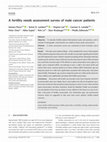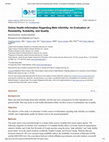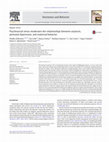Papers by Phyllis Zelkowitz

Psychooncology, 2018
Objective: To describe fertility-related informational needs and practices, and to examine if dem... more Objective: To describe fertility-related informational needs and practices, and to examine if demographic characteristics are related to these needs and practices. Methods: A needs assessment survey was conducted at three Canadian cancer centres. Results: 192 male cancer patients (Mage = 33.6) completed the survey. Most patients (70%) recalled having had a discussion with a health care provider regarding their fertility and 44% banked their sperm. Patients reported not getting all the information that they wanted, eg, the risk that a future child may have the same type of cancer (78%), and what was covered by insurance plans (71%). Barriers to sperm preservation were urgency to begin cancer treatment (49%), not planning to have a child in the future (47%) and worries that cancer could be passed on to future children (38%). Participants' age and being the parent of a child were significantly associated with having had a discussion about fertility. Participants' age, province, being the parent of a child and the desire for future children were significantly associated with fertility preservation. Conclusions: Discussions with health care providers were more frequent, and fertility preservation rates were higher than in past studies, but still not all patients' questions were answered. Misconceptions about passing on cancer to one's child, and that sperm preservation will delay treatment, should be dispelled. Health care providers can ask patients if they have any desire to have children in the future as a way to initiate a discussion of fertility preservation. Key information gaps and psychosocial resource needs are suggested to fully meet male cancer patients' fertility-related concerns.

BACKGROUND:
Many men lack knowledge about male infertility, and this may have consequences for th... more BACKGROUND:
Many men lack knowledge about male infertility, and this may have consequences for their reproductive and general health. Men may prefer to seek health information online, but these sources of information vary in quality.
OBJECTIVE:
The objective of this study is to determine if online sources of information regarding male infertility are readable, suitable, and of appropriate quality for Internet users in the general population.
METHODS:
This study used a cross-sectional design to evaluate online sources resulting from search engine queries. The following categories of websites were considered: (1) Canadian fertility clinics, (2) North American organizations related to fertility, and (3) the first 20 results of Google searches using the terms "male infertility" and "male fertility preservation" set to the search locations worldwide, English Canada, and French Canada. Websites that met inclusion criteria (N=85) were assessed using readability indices, the Suitability Assessment of Materials (SAM), and the DISCERN tool. The associations between website affiliation (government, university/medical, non-profit organization, commercial/corporate, private practice) and Google placement to readability, suitability, and quality were also examined.
RESULTS:
None of the sampled websites met recommended levels of readability. Across all websites, the mean SAM score for suitability was 45.37% (SD 11.21), or "adequate", while the DISCERN mean score for quality was 43.19 (SD 10.46) or "fair". Websites that placed higher in Google obtained a higher overall score for quality with an r (58) value of -.328 and a P value of .012, but this position was not related to readability or suitability. In addition, 20% of fertility clinic websites did not include fertility information for men.
CONCLUSIONS:
There is a lack of high quality online sources of information on male fertility. Many websites target their information to women, or fail to meet established readability criteria for the general population. Since men may prefer to seek health information online, it is important that health care professionals develop high quality sources of information on male fertility for the general population.

Hormones and Behavior, 2014
The hormone oxytocin (OT) is of particular interest in the study of childbearing women, as it has... more The hormone oxytocin (OT) is of particular interest in the study of childbearing women, as it has a role in the onset and course of labor and breastfeeding. Recent research has linked OT to maternal caregiving behavior towards her infant, and to postpartum depressive symptomatology. There is also evidence that psychosocial adversity affects the oxytocin system. The present study investigated the relationship of endogenous OT in women during pregnancy and at 8 weeks postpartum to psychosocial stress, maternal symptoms of depression, and maternal sensitive behavior. It was hypothesized that OT would mediate the effects of maternal depressive symptoms on maternal interactive behavior. We also tested the hypothesis that psychosocial stress would moderate the relationship between OT and maternal depressive symptoms and sensitive behavior. A community sample of 287 women was assessed at 12-14 weeks of gestation, 32-34 weeks of gestation, and 7-9 weeks postpartum. We measured plasma OT, maternal symptoms of depression and psychosocial stress. At the postpartum home visit, maternal behavior in interaction with the infant was videotaped, and then coded to assess sensitivity. In the sample as a whole, OT was not related to maternal depressive symptoms or to sensitive maternal behavior. However, among women who reported high levels of psychosocial stress, higher levels of plasma OT were associated with fewer depressive symptoms and more sensitive maternal behavior. These results suggest that endogenous OT may act as a buffer against the deleterious effects of stress, thereby protecting high risk women from developing depressive symptoms and promoting more sensitive maternal interactive behavior.

Introduction: Postpartum depression (PPD) is a relatively common mental disorder in the first yea... more Introduction: Postpartum depression (PPD) is a relatively common mental disorder in the first year following birth that is estimated to affect more than 10% of mothers. Although some studies have looked at women's perceptions of PPD, little is currently known regarding how they perceive their symptoms and how their partners do. Methods: Qualitative study using semi-structured interviews from 60 participants (30 heterosexual couples). Results: Men and women attributed PPD symptoms to nine different causes; except for one, all these causes were similarly endorsed by men and women. Biophysical issues, transition to parenthood and social connectedness and support were the most reported causes. All of the participants perceived PPD symptoms as being multicausal. Conclusion: Men and women mostly attribute PPD symptoms to similar causes. More research is needed regarding intra-couple perceptions.

Psychoneuroendocrinology, 2014
The present longitudinal study examined the relations between plasma oxytocin, theory of mind, an... more The present longitudinal study examined the relations between plasma oxytocin, theory of mind, and maternal interactive behavior during the perinatal period. A community sample of women was assessed at 12-14 weeks gestation, 32-34 weeks gestation, and 7-9 weeks postpartum. Oxytocin during late pregnancy was significantly positively correlated with a measure of theory of mind, and predicted theory of mind ability after controlling for parity, maternal education, prenatal psychosocial risk, and general anxiety, measured during the first trimester. Theory of mind was associated with less remote and less depressive maternal interactive behavior. Oxytocin, across all time points, was not directly related to maternal interactive behavior. However, there was a significant indirect effect of oxytocin during late pregnancy on depressive maternal behavior via theory of mind ability. These preliminary findings suggest that changes in the oxytocinergic system during the perinatal period may contribute to the awareness of social cues, which in turn plays a role in maternal interactive behavior.
Perspectives in Psychiatric Care, 2015
To compare the preferences of those who accept a mental health assessment and those who do not. T... more To compare the preferences of those who accept a mental health assessment and those who do not. Thirty couples participated in a qualitative study. Nineteen couples accepted a mental health assessment and 11 declined. Acceptors wanted more contact with professionals. Decliners preferred support from their informal network, parental leave, and exercise. However, acceptors also cited these preferences. Nurses should tailor care to couples' preferences, helping them identify and utilize preferred resources. Mental health care might be more acceptable to decliners if provided in obstetrical care.
Journal of the American Academy of Child & Adolescent Psychiatry, 2001

Journal of the American Academy of Child & Adolescent Psychiatry, 1996
To examine risk factors associated with borderline pathology in latency-age children. The subject... more To examine risk factors associated with borderline pathology in latency-age children. The subjects were 98 children assessed for day treatment. Borderline subjects were identified in a chart review using the Child Diagnostic Interview for Borderlines, which divided the sample into borderline (n = 41) and nonborderline (n = 57) groups. Functional levels were assessed by Children's Global Assessment Scale scores. The risk factors were also rated by chart review; all subjects were given a cumulative abuse score and a cumulative parental dysfunction score. Both groups demonstrated severe functional impairment. The risk factors that differentiated the borderline group were sexual abuse, physical abuse, severe neglect, and parental substance abuse or criminality. Sexual abuse and severe neglect were significant in multivariate analysis. Cumulative abuse and cumulative parental dysfunction scores were both higher in the borderline group. The findings indicate that the risk factors in borderline children are similar to those found in adults.






Uploads
Papers by Phyllis Zelkowitz
Many men lack knowledge about male infertility, and this may have consequences for their reproductive and general health. Men may prefer to seek health information online, but these sources of information vary in quality.
OBJECTIVE:
The objective of this study is to determine if online sources of information regarding male infertility are readable, suitable, and of appropriate quality for Internet users in the general population.
METHODS:
This study used a cross-sectional design to evaluate online sources resulting from search engine queries. The following categories of websites were considered: (1) Canadian fertility clinics, (2) North American organizations related to fertility, and (3) the first 20 results of Google searches using the terms "male infertility" and "male fertility preservation" set to the search locations worldwide, English Canada, and French Canada. Websites that met inclusion criteria (N=85) were assessed using readability indices, the Suitability Assessment of Materials (SAM), and the DISCERN tool. The associations between website affiliation (government, university/medical, non-profit organization, commercial/corporate, private practice) and Google placement to readability, suitability, and quality were also examined.
RESULTS:
None of the sampled websites met recommended levels of readability. Across all websites, the mean SAM score for suitability was 45.37% (SD 11.21), or "adequate", while the DISCERN mean score for quality was 43.19 (SD 10.46) or "fair". Websites that placed higher in Google obtained a higher overall score for quality with an r (58) value of -.328 and a P value of .012, but this position was not related to readability or suitability. In addition, 20% of fertility clinic websites did not include fertility information for men.
CONCLUSIONS:
There is a lack of high quality online sources of information on male fertility. Many websites target their information to women, or fail to meet established readability criteria for the general population. Since men may prefer to seek health information online, it is important that health care professionals develop high quality sources of information on male fertility for the general population.
Many men lack knowledge about male infertility, and this may have consequences for their reproductive and general health. Men may prefer to seek health information online, but these sources of information vary in quality.
OBJECTIVE:
The objective of this study is to determine if online sources of information regarding male infertility are readable, suitable, and of appropriate quality for Internet users in the general population.
METHODS:
This study used a cross-sectional design to evaluate online sources resulting from search engine queries. The following categories of websites were considered: (1) Canadian fertility clinics, (2) North American organizations related to fertility, and (3) the first 20 results of Google searches using the terms "male infertility" and "male fertility preservation" set to the search locations worldwide, English Canada, and French Canada. Websites that met inclusion criteria (N=85) were assessed using readability indices, the Suitability Assessment of Materials (SAM), and the DISCERN tool. The associations between website affiliation (government, university/medical, non-profit organization, commercial/corporate, private practice) and Google placement to readability, suitability, and quality were also examined.
RESULTS:
None of the sampled websites met recommended levels of readability. Across all websites, the mean SAM score for suitability was 45.37% (SD 11.21), or "adequate", while the DISCERN mean score for quality was 43.19 (SD 10.46) or "fair". Websites that placed higher in Google obtained a higher overall score for quality with an r (58) value of -.328 and a P value of .012, but this position was not related to readability or suitability. In addition, 20% of fertility clinic websites did not include fertility information for men.
CONCLUSIONS:
There is a lack of high quality online sources of information on male fertility. Many websites target their information to women, or fail to meet established readability criteria for the general population. Since men may prefer to seek health information online, it is important that health care professionals develop high quality sources of information on male fertility for the general population.